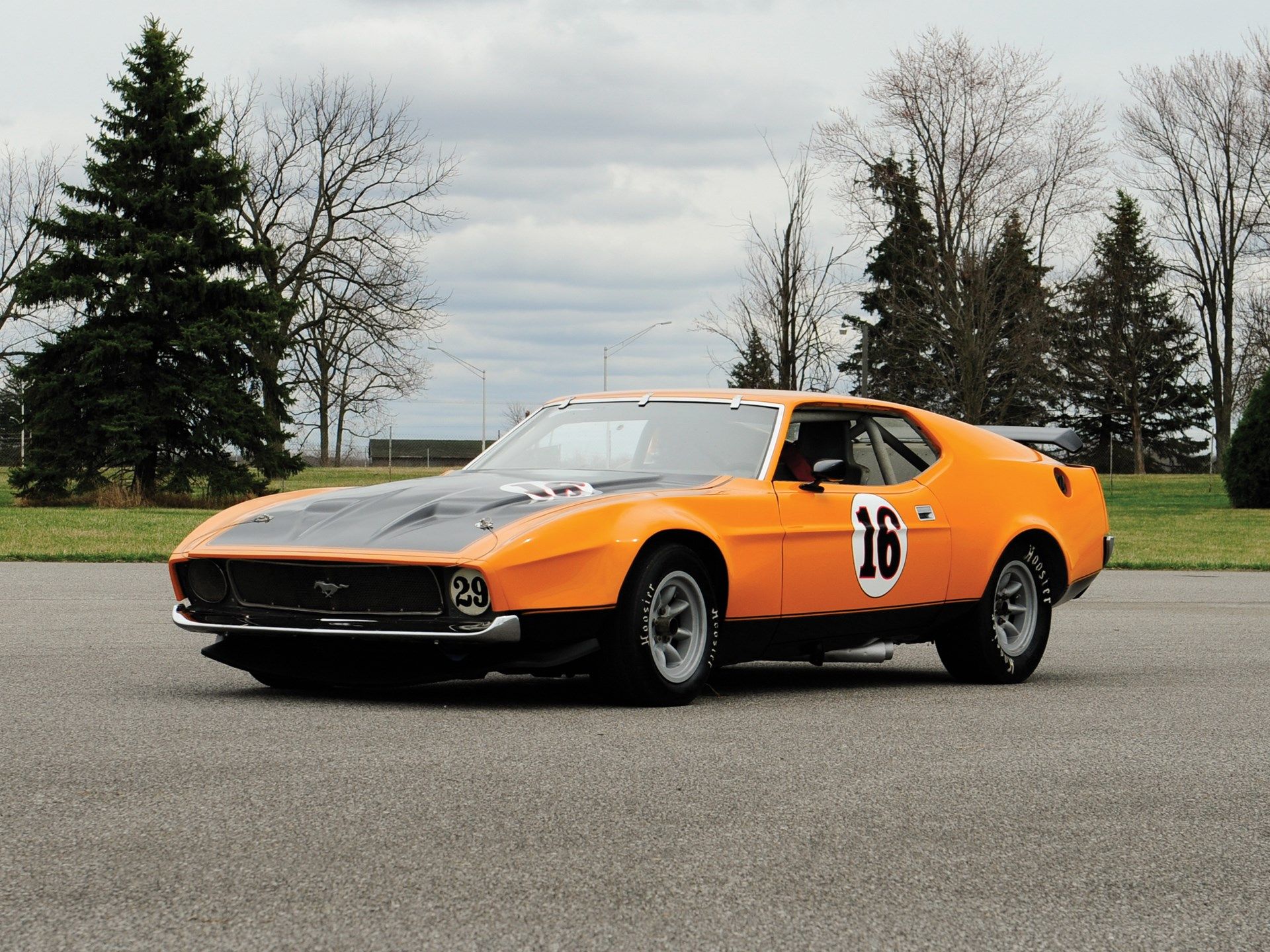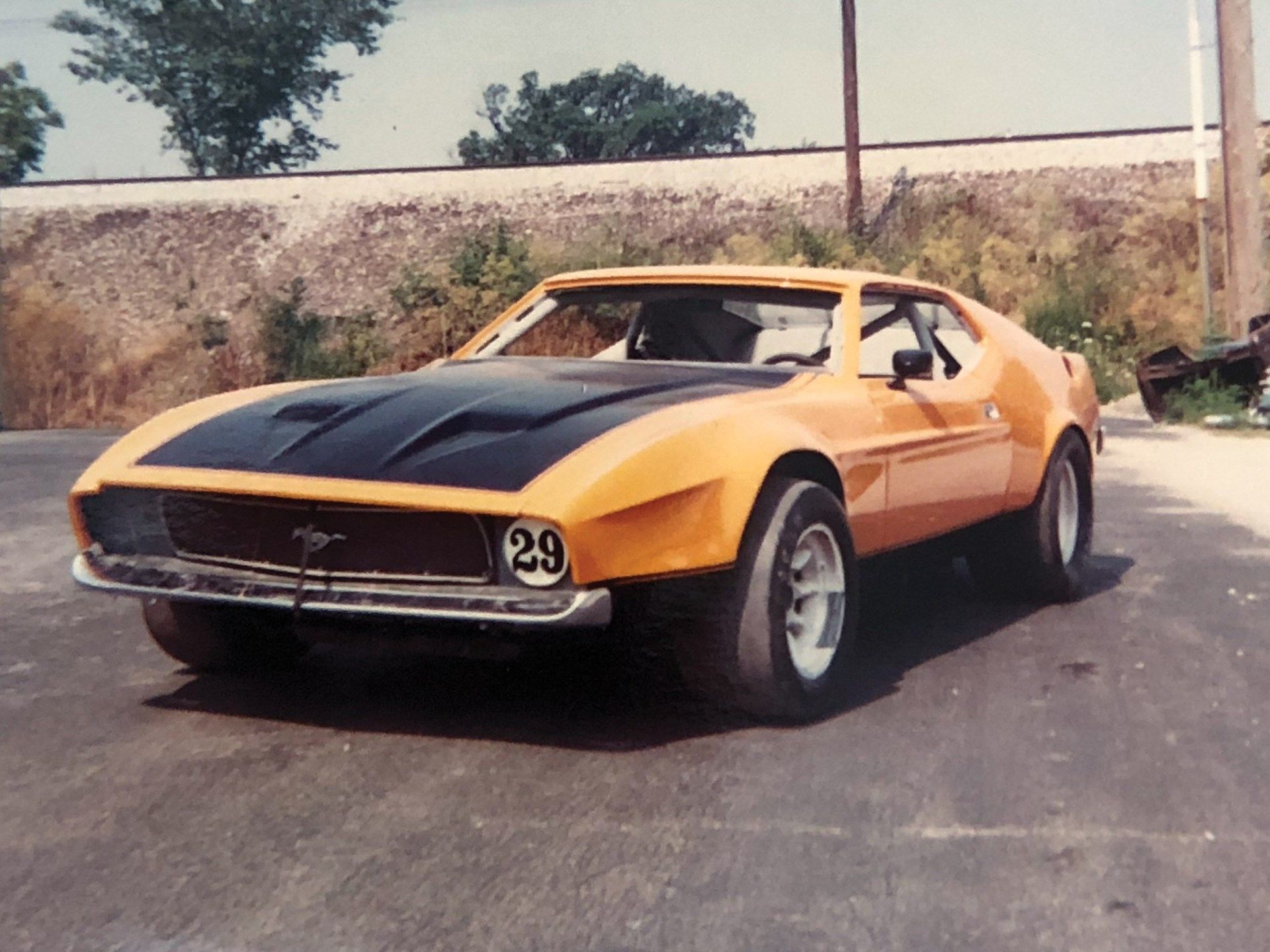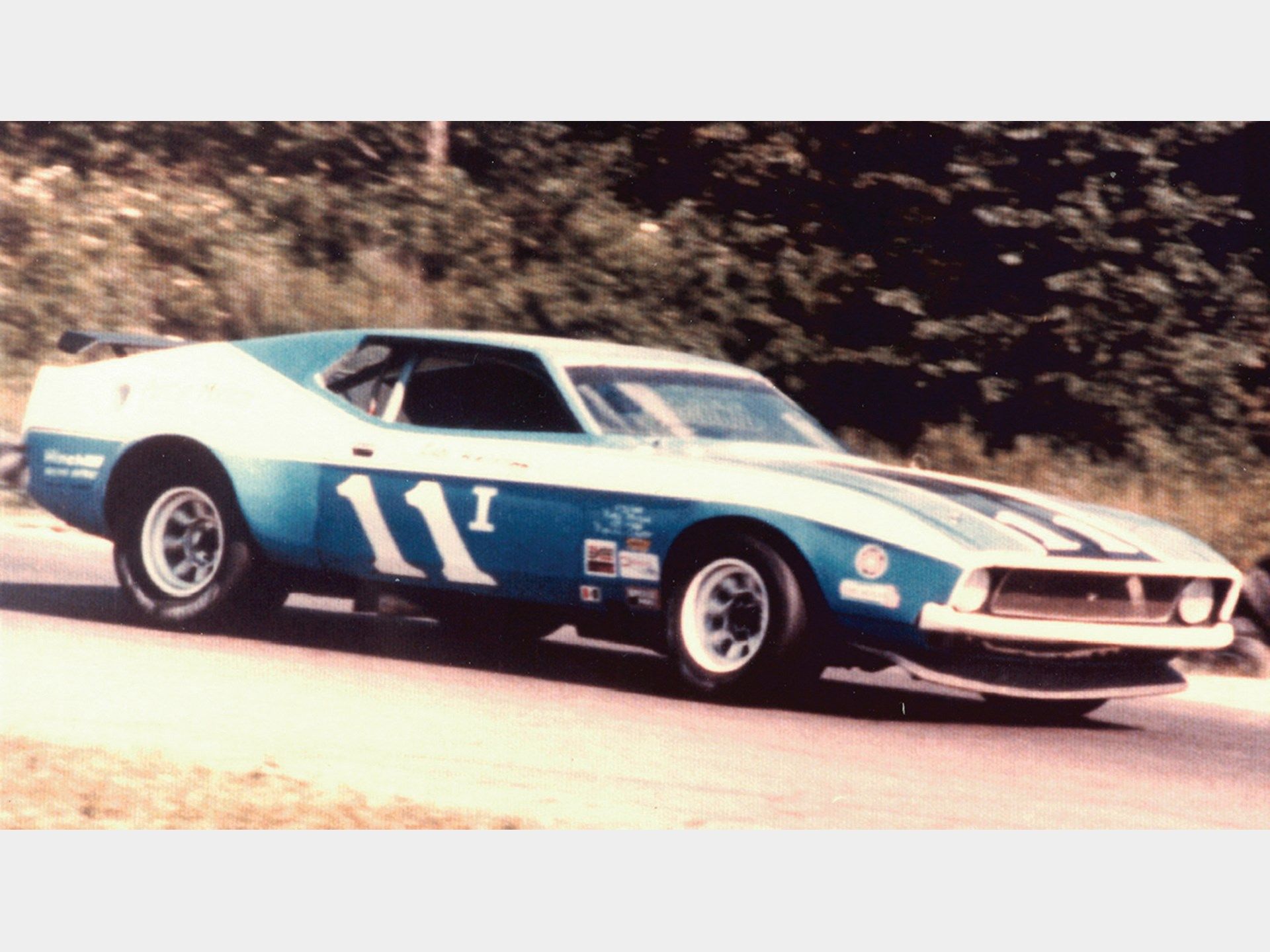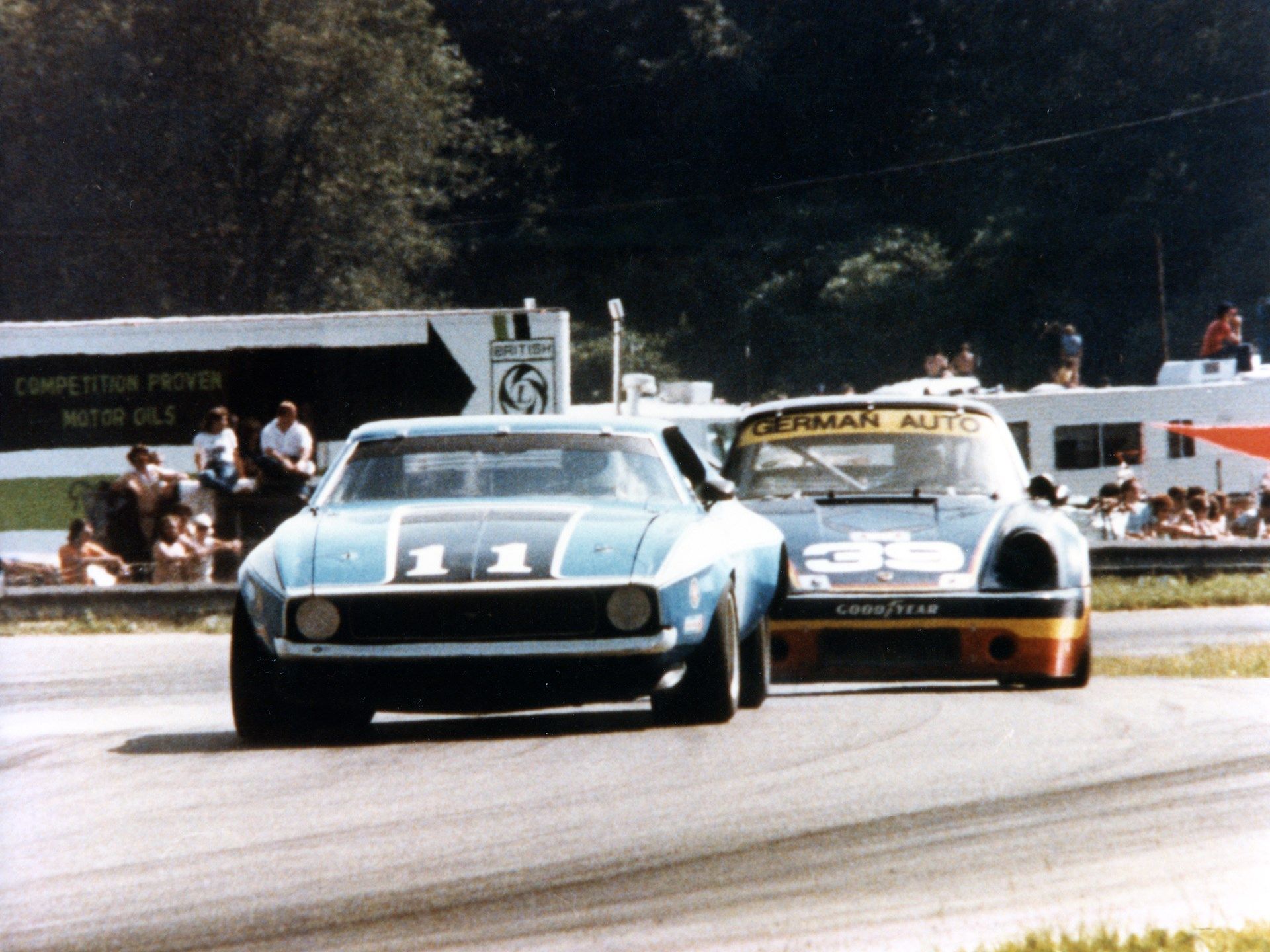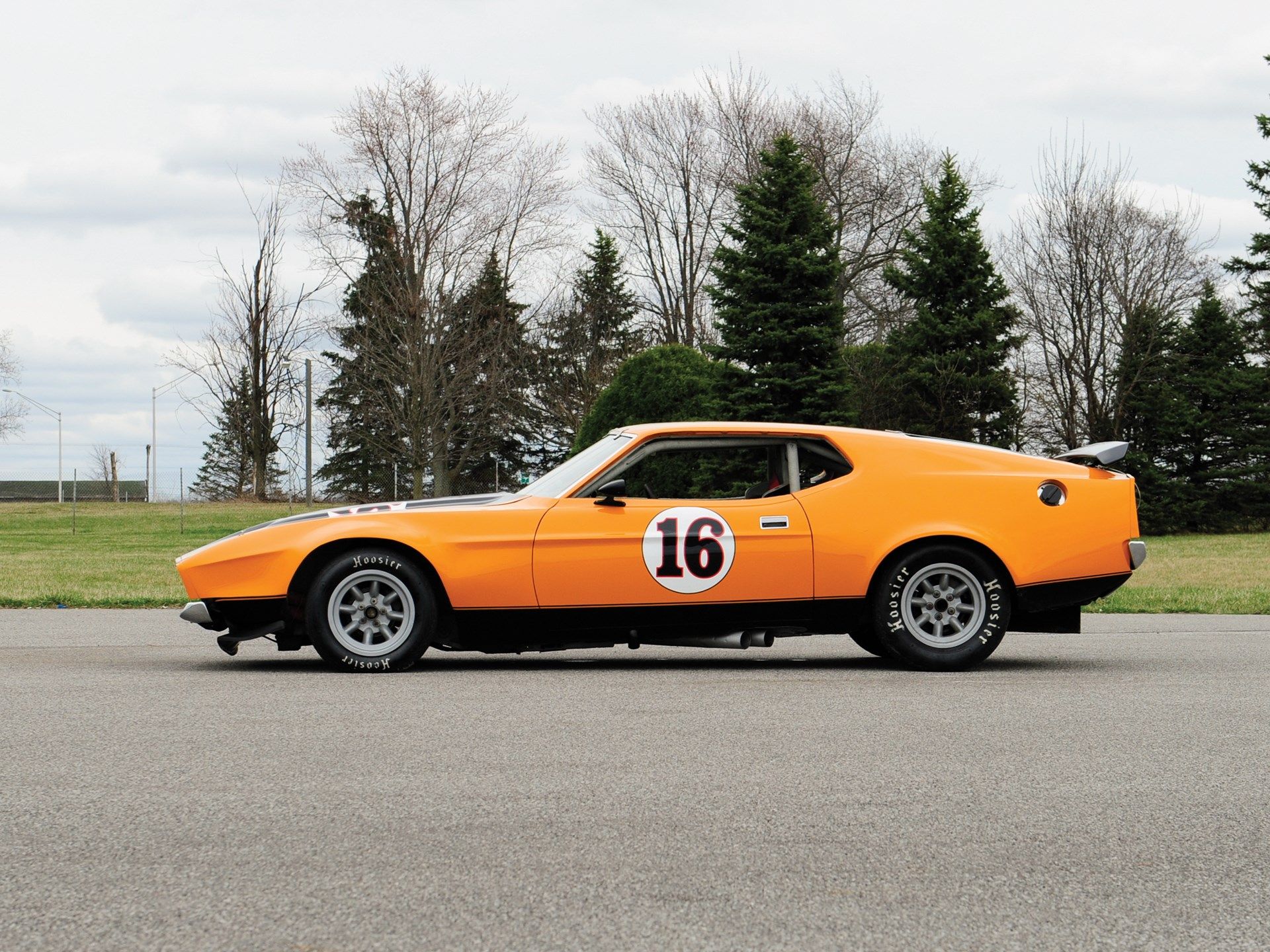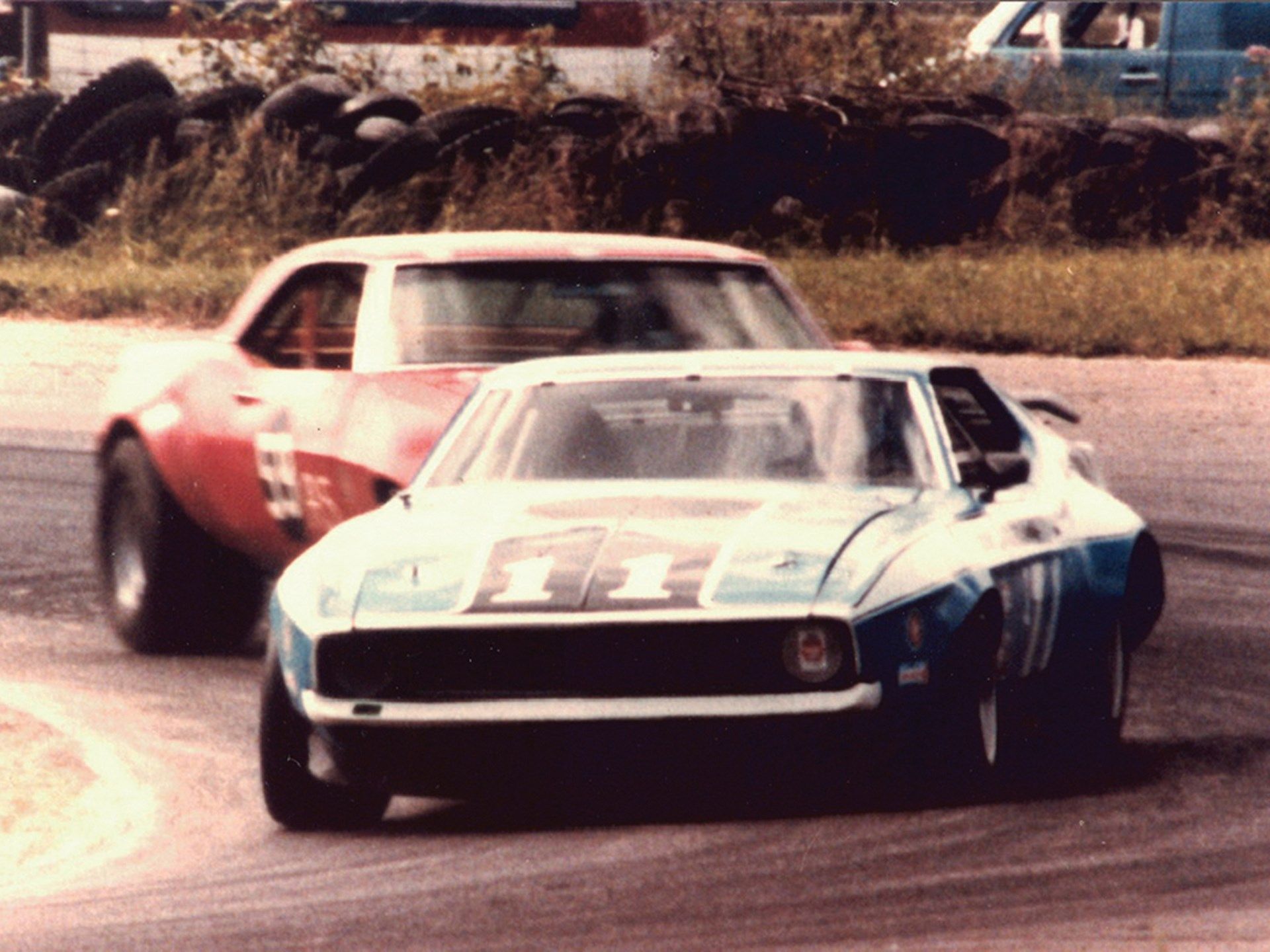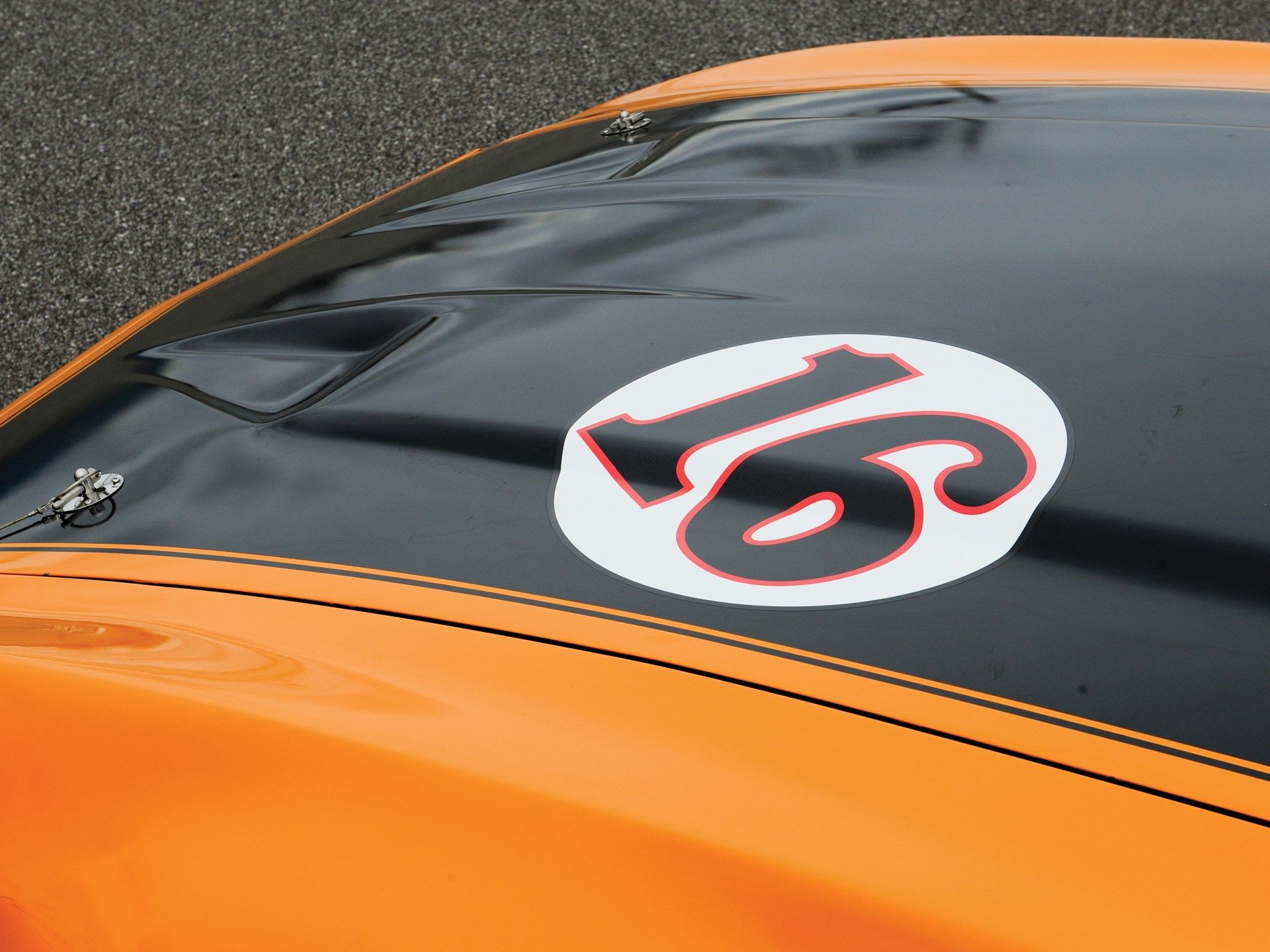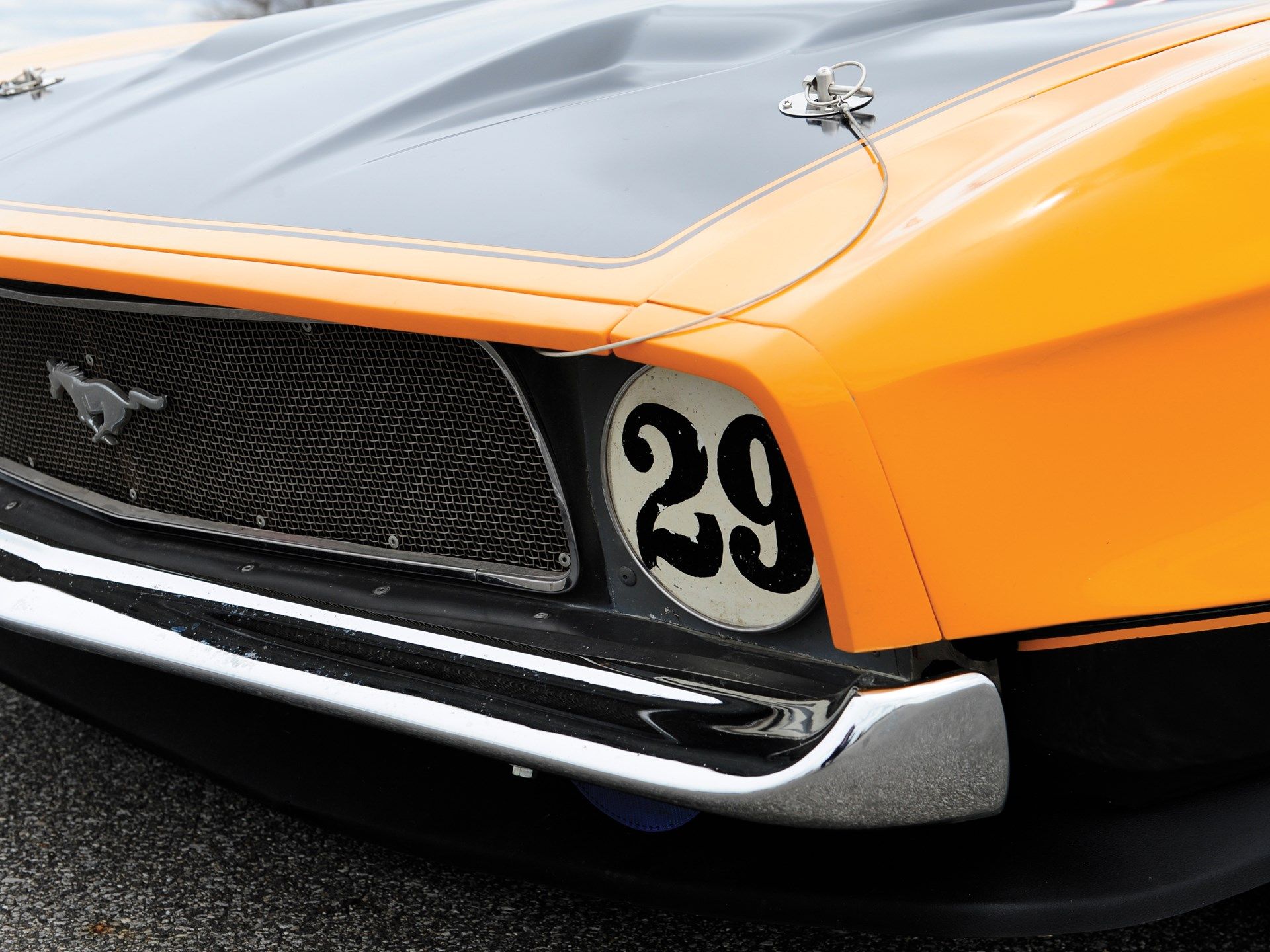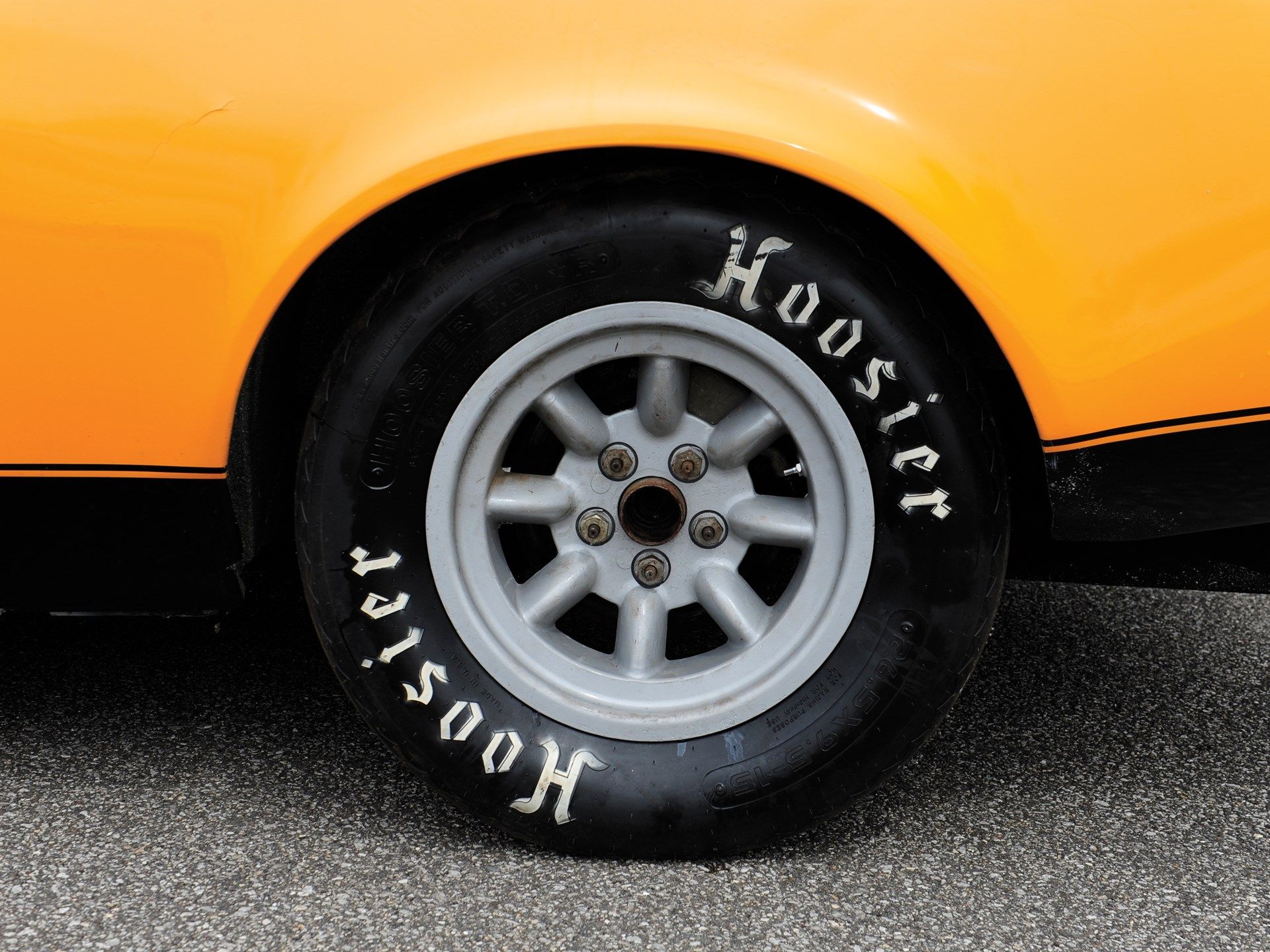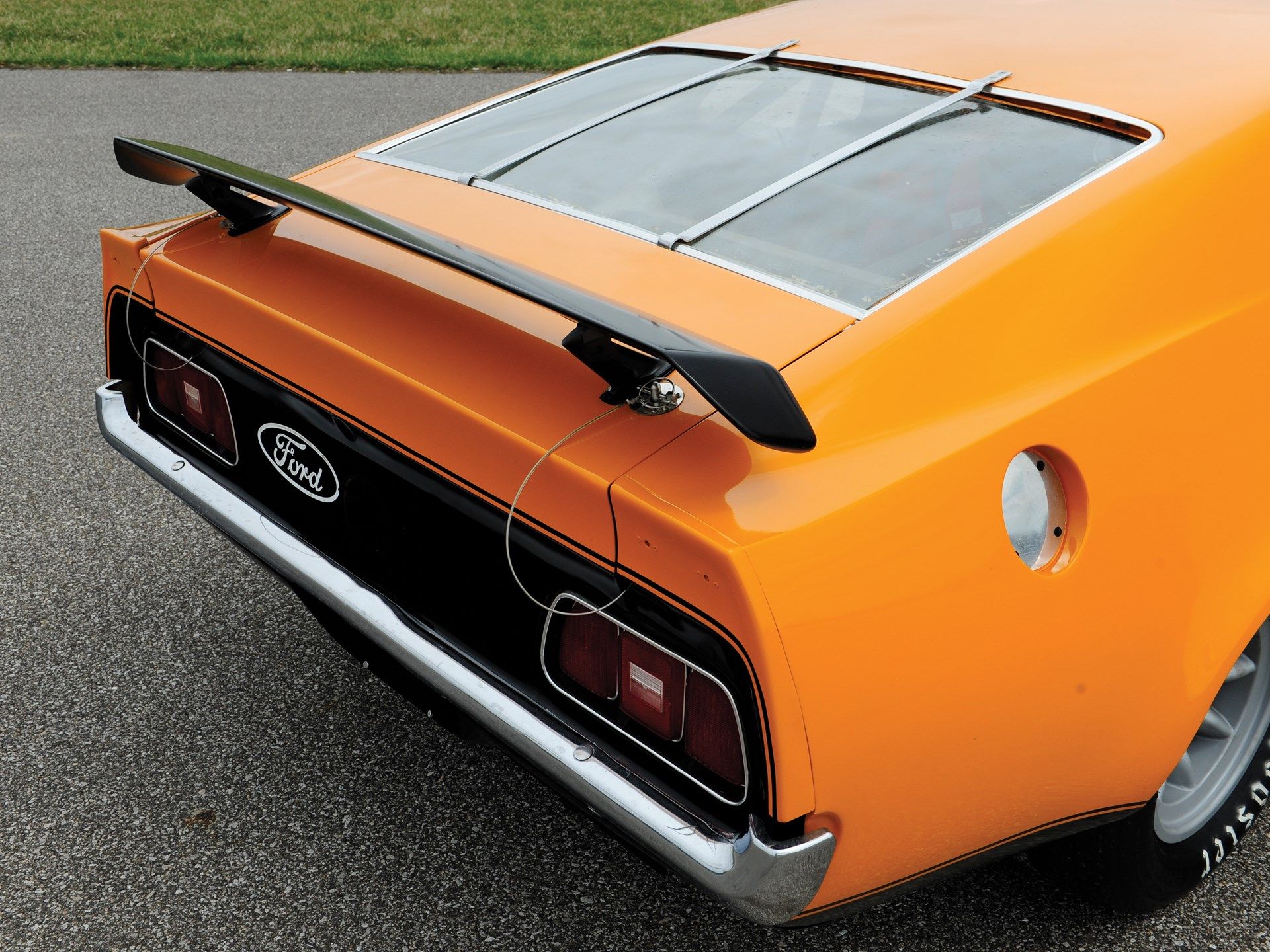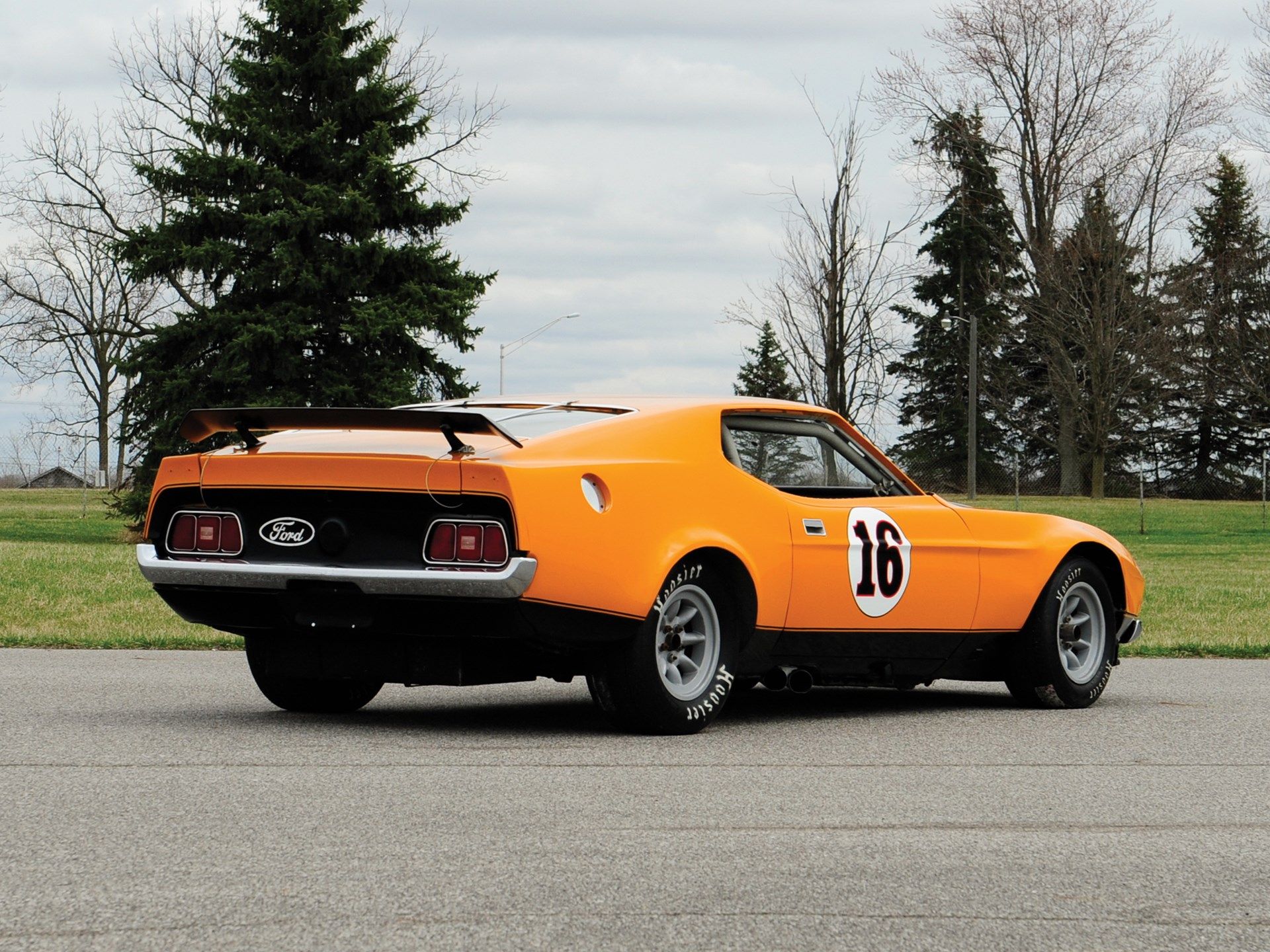The Ford Mustang, America's pony car, grew from being one of the most compact two-door performance cars on sale in the U.S. to looking like an obese coupe brought to its knees by the fuel crisis and the most recent pollution regulations. The change began in 1971 but this is not one of those sluggish, choking 'Stangs. Instead, this is a Kar Kraft-tuned Trans-Am racer complete with a Roush-built 5.75-liter Windsor V-8, a 4.11:1 locked differential, and a very low, plunging nose. It's an ultra-rare piece of history that, while not particularly successful in competition, proves the '71-'73 Mustang wasn't that big of a dud after all.
Sedan racing was big Stateside in the mid-to-late '60s with the formation of SCCA's Trans-Am Championship in '66 drawing on the popularity of the A-Production and B-Production SCCA classes. At the peak of its popularity, the Trans-Am was a bona fide battleground with all the key muscle car makers involved including Chevy, Dodge, Plymouth, Pontiac, and, of course, Ford. However, this Mustang didn't race in those glory days. It arrived a little too late, after the championship changed its focus from sedans and coupes and onto GT-style cars, following in the footsteps of the increasingly popular IMSA GT Series.
You can own the baddest '73 Mustang out there
If you've seen the new 'Ford v. Ferrari' movie, you might remember a few scenes at the beginning of the picture where Lee Iacocca's character, played by Jon Bernthal, made the point that buying Ferrari would not only allow Ford to fast-track its entrance in the sports car market, but also increase sales through the appeal that Ferrari holds as a brand and, also, its success on the racing tracks.
It is no wonder, in this context, that a series dedicated to sedans and coupes caught on at the time when the SCCA established the Trans-American Sedan Championship. In its first season, the cars racing in Trans-Am were divided into two classes: 'O2L' and 'U2L'. The 'O2L' class was for cars powered by engines bigger than 2.0-liters in capacity while the 'U2L' class fitted stuff like Alfa's Giulia GTA, the Volvo Amazon, the Mini Cooper, and others alike.
In its first season, the title was snatched by a 'U2L' car, the Alfa Romeo GTA driven by future F1 World Champion Jochen Rindt of Austria who edged ahead of Horst Kwech driving similar machinery. Alfa also took the Manufacturer's crown in the lower division while Bob Tullius driving for Dodge became the inaugural 'O2L' champion although it was Ford with its Mustang and the odd Falcon that bagged the Manufacturer's trophy. In '67, the Mustang (in notchback form) had to beat Mercury's new Cougar to take its second consecutive Manufacturer's crown in what was a genuine fratricide rivalry as Mercury was a Ford-owned brand.
Shelby American entered the picture in '67, campaigning the factory-backed Mustangs as the competition was hotting up.
AMC also joined in on the fun and, by 1970, when the muscle car bubble was arguably as big as it ever got, there were no less than six major American automakers represented on the grid via factory-backed outfits.
The duty of building Ford's Trans-Am-spec Mustangs fell on the shoulders of Kar Kraft, the independent contracted by and established with the help of the Blue Oval in 1965 to bring that elusive Le Mans winner's trophy to Dearborn. As a pukka factory racing department, Kar Kraft would also work on Ford's NHRA, NASCAR, and Can-Am cars, although Ford was never too interested in the big Group 7 prototypes after conquering the old 'sacred cow' in France.
In short, Kar Kraft wasn't really a part of FoMoCo - in order to circumvent all the bureaucracy that stalled things in the road car departments - but it never worked on anything other than cars under the Ford umbrella. It also did a lot of research and development for future road cars and even assembled the 1969-1970 Mustang Boss 429 at its Brighton plant. In short, after the Ford GT program came to an abrupt end after the 1967 edition of the 24 Hours of Le Mans, Kar Kraft divided its time between 'Special Vehicles Activity' or road-focused R&D and the building of Ford's other race cars up until the early '70s.
In 1968, Fran Hernandez became the Mustang Trans-Am program boss after one year spent on the Mercury side while Shelby was running the 'Stangs. Fernandez and Kar Kraft took over entirely that year but the change in leadership didn't help as Ford's stubborn decision to equip the cars with tunnel port cylinder heads (they ran 5.0-liter V-8s as per the regulations that limited engine capacity for 'O2L' cars to five liters) saw the Camaros leave them dead in the water throughout the year. Lee Dykstra, the Trans-Am program's Chief Engineer, argued at the time that this was also because Chevrolet 'out-homologated' the Camaro Z28 in that it managed to slip through past the SCCA, benefitting from its benevolence, parts otherwise unavailable on street-going Z28s (not even on dealer option sheets).
According to Mitch Marchi, noted Kar Kraft engineer, the factory-backed Mustangs would go through a sleuth of engines over a race weekend with as much as six expiring by the end of Sunday's three-hour race. Frustrated by the situation, and an edict by Ford disallowing Kar Kraft to fiddle with any engine prior to throwing it in the car, the mechanics finally disobeyed the orders coming from Dearborn and analyzed one supposedly brand-new unit. It came with loose rocker arm bolts.
The embarrassing situation reached the ears of the right suits up in Dearborn and, for 1969, Kar Kraft was given the chance to build its own engines. Four cars were at the receiving end of Ford's flow of cash: Bud Moore Engineering and Shelby American. The two-team, four-car operation was overseen by Homer Perry. After a disastrous season with the notchback, Ford would move on to campaign a new model, the Mustang Fastback Boss 302.
The Boss 302 was a new powerplant with canted-valve heads instead of the tunnel port heads of the 305 that came before it. Designated as a High-Output (HO) unit, it was supposed to make as much as 500 horsepower in street trim and take on the Z28 head-on. The Boss 302 must not be confused with the Boss 429 (aka the 'NASCAR Mustang' because it was used to homologate the NASCAR-bound 429 V-8) that Kar Kraft also built at the time. The '69 Trans-Am racer was based on the Boss 302. The wheels started rolling after Semon "Bunkie" Knudsen, Ford's President at the time, greenlit the 302 for production in late September of '68. During that same meeting, the board agreed upon the 'Boss' name while the well-known graphics on the street-legal model were the creation of Larry Shinoda who first tried out the design on his own Mustang.
The seven cars converted to Trans-Am spec for 1969 began their lives as stock, fully trimmed, road-worthy Boss 302s. The cars all arrived at Kar Kraft's Hagerty Road facility where they were taken apart and expertly put back together with all the go-fast bits in place to make them Trans-Am ready.
The final aerodynamic package featuring a lip spoiler in the front and a ducktail in the rear (for 1970, the Boss would sport a separated wing atop the rear deck) was tested in the wind tunnel belonging to the University of Maryland in July of '69. Dykstra also tried out the 1970-spec parts while there and even a mock-up of the 1971 design as it was already under consideration with Knudsen looking to move the Mustang nameplate more upmarket and dive into the personal luxury car sector.
Further time spent in wind tunnels would end up slightly augmenting the shape of the Mustang's nose as the tip of the front end, including the headlight sockets, radiator grille opening, was dropped by one inch so that the nose actually dived down towards its edge in the front. The change was minimal enough to not require much cutting and welding and also to not disrupt any trim pieces along the side and the doors. This is the way in which the cars ran while the road cars came with the taller nose - something that the SCCA officials did not spot.
All the work was fructuous and Ford came out ahead at the end of 1970, champion George Follmer driving for Bud Moore Engineering. You could argue that the success of the Mustang was aided by a series of favorable circumstances: that Penske moved over from Chevy to AMC to run the Javelin and 1970 was its first year of racing that car after it'd been prepared by Ron Kaplan and Jim Jeffords' Javelin Racing Team. Chaparral, famed builder of Can-Am cars had big shoes to fill taking over the Chevy Trans-Am program and Jim Hall's men weren't helped by the fact that a new Camaro was introduced for 1970. Then there were Pontiac, Plymouth, and Dodge. All three could've been fast contenders, provided proper funding would've been there, but it never was. Dan Gurney switched to running, via his own All-American Racers squad, the 'Cudas, and the sluggish Challengers were entered by Autodynamics.
The two Moore cars found a new owner in Tony DeLorenzo who, with sponsorship from Troy Promotions Inc., raced them in '71 but could only watch as Mark Donohue & Penske romped away with the title. Soon after the Trans-Am program ended, Kar Kraft also closed its doors.
Before Kar Kraft went out of business, Warren Tope's father, a Ford VP at the time, ordered a pair of '73 MY Mustang body-in-whites through his connections.
While Tope's car was completed without much fuss using blueprinted Kar Kraft parts and some leftovers, he didn't put it on a grid right away. In fact, records show that Tope raced his trustworthy 1970-spec Boss 302 in the first few rounds of the 1973 season before switching to a De Tomaso Pantera in an effort to keep up with the slew of Porsche 911s that joined the series.
Hinchcliff lacked Tope's resources and this meant he needed almost three years to finish working on the car and, without any other newer alternative (he also had a 1970 Boss 302 that he'd raced up until 1972), he entered it in the 1977 SCCA Trans-Am Series. By that time, turbocharged Porsches were running amok at the sharp end of the Trans-Am field, in Division II, while old-fashioned sedans such as Hinchcliff's Mustangs were entered in Division I. The car features some key Kar Kraft developments such as the full-floater rear axle with locker, four-piston Girling aluminum brakes with large rotors, and a Ram Air intake with Holley intake manifold. The engine was the Boss' 351 (5.8-liter) V-8, the correct engine for the unborn 1971 factory-backed program.
While Hinchcliff did get the car approved by the SCCA in October of '76, it wasn't until June of 1977 that the car actually saw track action during the Nelson Ledges Trans-Am round. It finished a lonely 17th on the day, four laps behind John Bauer's class-winning Porsche 911. Things didn't improve at Road America and a ninth place in qualifying, while promising, yielded nothing in the race with Hinchcliff retiring in September's Mt. Tremblant round in Canada.
Two years later, Hinchcliff brought the car out again, this time for the six-hour endurance race at Watkins Glen that was both a Trans-Am round and the American venue for the World Championship of Makes. The car was entered by William Maier and co-driven by Maier, Hinchcliff, and Art Siri, Jr. in the race. Finally, come 1980, the heavily revised Mustang (complete with an almighty front air dam) was entered in a few races and finished a career-best 11th overall in the Trois-Rivieres round, three laps behind race winner Roy Woods at a time when Trans-Am moved away from IMSA GTX/Group 5 machinery and only allowed IMSA GTO/Group 4-style cars in an effort to return to their roots that didn't really work out.
After switching to a Corvette for '81-'83, Hinchcliff sold the Mustang to George Boyd who duly repainted it in Grabber Orange, the color of Bud Moore's cars in 1970.
It goes without saying that the car as it will be sold during RM/Sotheby's Auburn Spring Sale needs to be thoroughly restored before it can be raced in historic events. However, when such a restoration is completed, this will be one of the world's rarest racing Mustangs, a case of "what could've been" had Ford not canceled its Trans-Am program.

